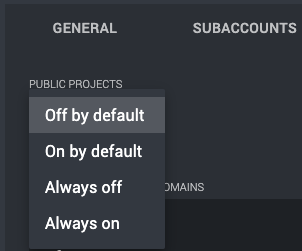What is Public Projects and how can I use this feature?
If you as a company have many users who need access to specific projects in Refapp to, for example, see the reference report, it can be time-consuming to add them to all projects manually. There is then a function you can turn on called "Public project". Projects in this category are visible to all users in that subaccount, regardless of the user's permissions. The user is then not active in the project and can not send out any communication to referees and candidates or change any settings.
Setting up the feature
Administrators can enable the feature in Company Settings under the Security tab. In the dropdown menu under Public projects, there are then a few different settings to choose from:
Off by default - The function is activated but must be actively selected in the project settings.
On by default - If a new project is created, the function will automatically be switched on.
Always off - The function is entirely off.
Always on - All projects in the company will automatically be set as public.

To control the feature in a project, do so in the project settings under the Security and integrity tab. There is now a button you can press to make the project public.

In the list of projects, public projects will now have a symbol to see which projects are public easily.

How to use the feature
The user still only sees their own projects in the list of their reference checks, but there is now a button called Show All Projects. If that button is activated, then the user can see all public projects in its subaccount and their own.

If you go into the public project, you can see candidates, referees and the reference report. If the user tries to do something else, such as editing the candidate's contact information, they receive this message.

If the user is to assist in the reference checking and needs access to the project, they can click on the plus sign under the project name and select a colleague to contact to request access. The colleague will then receive an email with a link to the project where it can easily add the user to the project.

